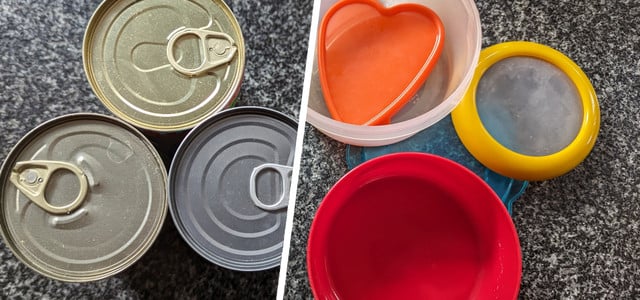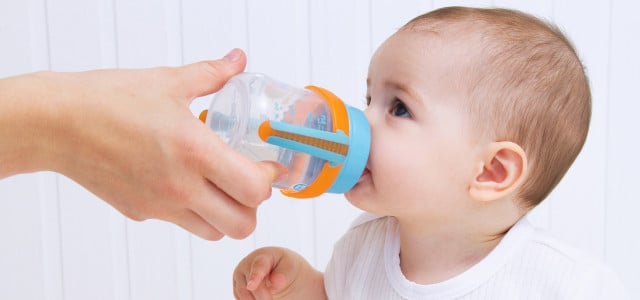
Recent studies suggest that the chemical bisphenol A (BPA) could be dangerous in much smaller amounts than previously thought. And we still encounter the risky chemical in many everyday objects and foods. Utopia explains what to look out for and how to find more environmentally and health friendly alternatives to products with BPA.
Bisphenol A (BPA) is one of the chemicals that is very difficult to completely avoid in everyday life: it is found in snack boxes, kettles, drinking bottles and kitchen bowls, for example. But also in tins, as the current test of peeled tomatoes by Öko-Test (July 2023) shows:
Bisphenol A: The limit has been reduced by a factor of 20,000
For a long time, little was heard of bisphenol A after the production of baby bottles made of polycarbonate with BPA was banned in 2011 and the ban was extended to drinking bottles and containers for babies and children in 2018 – until spring of this year. Since April 2023 there has been a new assessment by the European Food Safety Authority (EFSA).
The result: Based on recent studies, EFSA came to the conclusion that BPA can be dangerous for humans in much smaller amounts than previously thought. In April 2023, it published a reassessment, lowering the BPA Tolerable Daily Intake (TDI) value set in its previous assessment (2015). And clearly: by a factor of 20,000.
The TDI value is the amount of bisphenol A that can be ingested daily over a lifetime without causing a significant health risk.
- EFSA recommendation from 2015: 4 micrograms per kilogram of body weight per day
- EFSA recommendation from 2023: 0.2 nanograms per kilogram of body weight per day
This means: The TDI value is now about 20,000 times lower than before.
According to EFSA, 800 new studies were included in the reassessment.
In Germany, the Federal Institute for Risk Assessment (BfR) is responsible for the assessment of pollutants from food packaging. In contrast to the EFSA, the BfR proposes a higher TDI of 0.2 micrograms per kilogram of body weight per day. According to the BfR, there is a lack of current data on the level of BPA exposure in the population.
What value should we use as a guide in the future? For the testers from Öko-Test, the answer is clear: “Öko-Test is based on the TDI of the EFSA. The value is also based on concrete scientific findings on the toxicological risk potential of the substance.”
What is bisphenol A anyway?
Bisphenol A (BPA) is a chemical used in the manufacture of the plastic polycarbonate and epoxy resins. These resins are used for the interior coating of beverage and food cans. The industrial chemical is one of the most commonly used synthetic chemicals in the world.
The problem with bisphenol A is that it is released from packaging into food and is released from plastics when heated and heated, thus getting into our food.
How dangerous is BPA?
BPA is considered a type of hormonal pollutant because it has an estrogen-like effect and alters hormone balance. The European Chemicals Agency has identified bisphenol as a “substance of very high concern with endocrine disrupting properties” because of its hormone-like mode of action.
BPA is particularly dangerous in sensitive phases of life such as pregnancy. The effects of BPA are associated with developmental disorders in girls and boys (precocity), behavioral disorders in children, but also reduced sperm count, impotence and infertility. BPA is also suspected of promoting breast cancer and obesity and having a negative effect on the immune system.
Where can Bisphenol A be found?
Bisphenol A is found in many everyday products, for example in:
-
Plastic items such as packaging, plastic tableware, drinking bottles and toys
-
Beverage and food cans (if coated with epoxy paint on the inside)
-
Food packaging (e.g. for fast food)
-
Tooth fillings (substances that can release bisphenol A during or after dental treatment are also used in the production of plastic tooth fillings and sealing compounds (= dental composites))
-
CDs, DVDs and Blu-rays
Good to know: Many products for infants and small children (e.g. pacifiers and baby bottles) are now BPA-free by law. BPA is now also banned from receipts. Here, however, many manufacturers have switched to bisphenol S (BPS) and bisphenol F (BPF). These bisphenols are also hormonally active. It is therefore best to refuse (white) paper receipts when making purchases. There are no bisphenols in the blue receipts.

Non-industry-funded studies have found BPA in air, dust, surface water and seawater, as well as in greenhouse fruit and drinking water in plastic tanks. In humans, BPA is found in blood, urine, amniotic fluid, uterine tissue – all studies have found the highest levels in children.
How to avoid BPA: 10 tips
- It is best to buy food fresh and avoid plastic packaging whenever possible. Here are 14 tips to avoid packaging in the supermarket.
-
Avoid canned foods. According to a study by the CVUA (Chemical and Veterinary Investigation Office Stuttgart), coconut milk, meat, sausage, stews and ready meals are particularly contaminated. If you’re buying cans: Transfer food from open cans to glass, ceramic, or stainless steel containers.
- It is best to store food in glass, ceramic or stainless steel containers. Also read our post: Living plastic-free: 12 amazing ideas for empty screw-top jars
-
Never heat food in plastic containers. If you want to store food in plastic containers, you should let them cool down first.
- When buying plastic cans, drinking bottles and plastic crockery, look for the “BPA-free” or “BPA-free” label.
- In the case of contact with food, the “safer” plastics should be preferred: polyethylene (abbreviated: PE) or polypropylene (abbreviated: PP).
-
Avoid polycarbonate: The plastic with the recycling code 7 (abbreviated: RE 7) often hides polycarbonate (abbreviated: PC), which contains bisphenol A.
- Before dental treatment, ask whether plastic fillings or sealing material contain bisphenol A. Then ask about alternative materials.
- When preparing baby food: Never put hot water in plastic bottles or heat baby food in plastic containers.
- It’s best to avoid baby food in clear, hard plastic containers that don’t specify the type of plastic or are labeled “PC” (for polycarbonate).

You are on the safe side with glass bottles. Glass is the optimal packaging for food because it is impermeable and product-neutral. That’s why baby food is only offered in jars. Glass bottles with shatterproof, protective coatings are also available for transporting beverages.
Even uncoated drinking bottles and lunch boxes made of stainless steel are free of BPA and other harmful substances.
Sources: Federal Environment Agency / Federal Institute for Risk Assessment (BfR) / Öko-Test
Read more on Techzle.com:
- BPA-free coffee mugs to go
- Plastic fasting: This is how you do without plastic step by step
- Plastic gets sticky? what you should do now